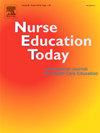Nursing students' test anxiety and academic self-efficacy, dishonesty and performance: A structural equation model
IF 4.2
2区 医学
Q1 EDUCATION, SCIENTIFIC DISCIPLINES
引用次数: 0
Abstract
Aims
To investigate the interrelationships among test anxiety, academic self-efficacy, academic dishonesty, and academic performance.
Background
Students' test anxiety and its adverse impacts on academic performance is well-documented globally. However, this study is the first to examine the mediating role of academic self-efficacy between test anxiety and academic dishonesty.
Design
Cross-sectional-correlational design.
Methods
Nursing students (n = 521) were consecutively recruited to participate from October 2024 to January 2025. Three standardized scales were used to collect data and were analyzed using covariance-based structural equation modeling.
Results
Test anxiety was negatively correlated with academic self-efficacy (β = −0.38, p = 0.001) and academic performance (β = −0.24, p = 0.001) while positively associated with academic dishonesty (β = −0.51, p = 0.001). Academic self-efficacy was negatively correlated with academic dishonesty (β = −0.13, p = 0.012). Academic self-efficacy mediated between test anxiety and academic dishonesty (β = 0.05, p = 0.016). The estimated variance of academic self-efficacy was 14.79 %, which was explained by test anxiety, while academic dishonesty had a variance of 31.48 %, measured by both test anxiety and academic self-efficacy. Finally, academic performance had an estimated variance of 5.86 % explained by test anxiety only.
Conclusion
Nursing students' test anxiety depletes their academic self-efficacy and academic performance while intensifying academic dishonesty. Academic self-efficacy mitigates academic dishonesty and demonstrates a mediating role between test anxiety and academic dishonesty.
护生考试焦虑与学业自我效能、不诚实与成绩:一个结构方程模型
目的探讨考试焦虑、学业自我效能感、学业不诚实与学业成绩的相互关系。学生的考试焦虑及其对学习成绩的不利影响在全球范围内都有充分的记录。然而,本研究首次考察了学术自我效能感在考试焦虑与学术不诚实之间的中介作用。DesignCross-sectional-correlational设计。方法于2024年10月至2025年1月连续招募护理学生521名。采用三个标准化量表收集数据,并采用基于协方差的结构方程模型进行分析。结果考试焦虑与学业自我效能感(β = - 0.38, p = 0.001)和学业成绩(β = - 0.24, p = 0.001)呈负相关,与学业不诚实(β = - 0.51, p = 0.001)呈正相关。学术自我效能与学术不诚实呈负相关(β = - 0.13, p = 0.012)。学业自我效能在考试焦虑和学业不诚实之间起中介作用(β = 0.05, p = 0.016)。学业自我效能的估计方差为14.79%,可以用考试焦虑来解释;而学业不诚实的估计方差为31.48%,可以用考试焦虑和学业自我效能来解释。最后,学业成绩的估计方差为5.86%,仅用考试焦虑来解释。结论护生的考试焦虑消耗了护生的学业自我效能感和学业成绩,加剧了护生的学术不诚信。学业自我效能减轻了学业不诚实,并在考试焦虑与学业不诚实之间表现出中介作用。
本文章由计算机程序翻译,如有差异,请以英文原文为准。
求助全文
约1分钟内获得全文
求助全文
来源期刊

Nurse Education Today
医学-护理
CiteScore
6.90
自引率
12.80%
发文量
349
审稿时长
58 days
期刊介绍:
Nurse Education Today is the leading international journal providing a forum for the publication of high quality original research, review and debate in the discussion of nursing, midwifery and interprofessional health care education, publishing papers which contribute to the advancement of educational theory and pedagogy that support the evidence-based practice for educationalists worldwide. The journal stimulates and values critical scholarly debate on issues that have strategic relevance for leaders of health care education.
The journal publishes the highest quality scholarly contributions reflecting the diversity of people, health and education systems worldwide, by publishing research that employs rigorous methodology as well as by publishing papers that highlight the theoretical underpinnings of education and systems globally. The journal will publish papers that show depth, rigour, originality and high standards of presentation, in particular, work that is original, analytical and constructively critical of both previous work and current initiatives.
Authors are invited to submit original research, systematic and scholarly reviews, and critical papers which will stimulate debate on research, policy, theory or philosophy of nursing and related health care education, and which will meet and develop the journal''s high academic and ethical standards.
 求助内容:
求助内容: 应助结果提醒方式:
应助结果提醒方式:


